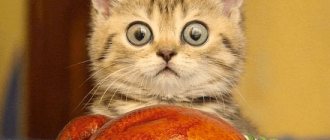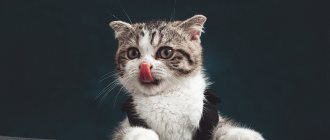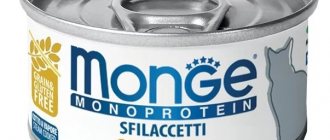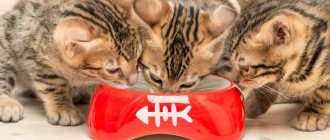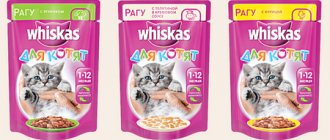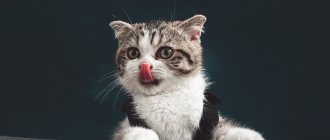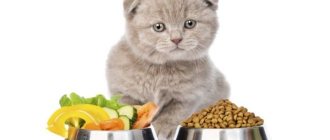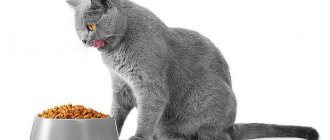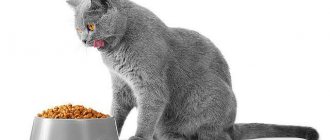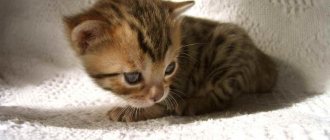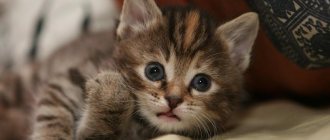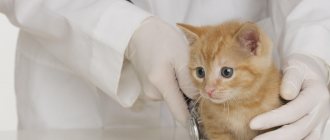- Cats
What to feed a kitten? It would seem like a simple question. Meat, milk, leftover soup and fried fish from the holiday dinner, or better yet, the popular Whiskas, which, according to the advertisement, has become even tastier.
Alas, in reality everything turns out to be not so simple. Many of the foods that we are used to giving our pets are harmful to them. As for cheap, but well-known foods, it is better not to buy them at all, unless you value the health of your tailed baby. There are some nuances in how many times to feed a kitten, and many other tricks that affect the healthy growth of the animal.
Kitten feeding regimen
To begin with, it is important to understand when to introduce complementary foods and how often to feed the kitten. You, of course, can be guided by the kitten's hungry look, but it is better not to awaken the beast in him, and 3-4 weeks after birth, begin to gradually feed the baby.
By 4 weeks of age, a stable eating schedule should be established.
The baby should receive additional feeding 4-7 times a day.
But there are stalemate situations when kittens need additional feeding much more often.
How many times a day should you feed your kitten?
- age up to 2 weeks – 10 times a day (with night coverage);
- feeding a one-month-old kitten – 8 times a day (including the night);
- 1 - 2 months - 7 times a day (night is already excluded);
- 2 - 3 months - 6 times a day;
- 4 months - 5 months - 5 times a day;
- 5 - 9 months - 4 times a day;
- 9 - 12 months - 3 times a day;
- Feeding kittens from 1 year of age becomes twice a day (for example, 9:00 – 21:00).
How much food to give a kitten:
- Age 1 week – 30 ml per 100 g of kitten weight;
- 2 weeks – 38 ml per 100 g of kitten’s weight;
- 3 weeks – 48 ml per 100 g of kitten’s weight;
- 4 weeks and subsequent – 48-53 ml per 100 grams of kitten weight.
How much should a kitten receive per day?
Of course, it’s easy to calculate the amount of feed based on the items already proposed, but we’ll make the task easier and give a few numbers:
- At 1.5 months, a baby needs about 120 grams of food per day;
- We feed a two-month-old kitten more - 160-180 grams per day;
- During the period of active growth (3 months - 6 months), the daily food intake is 180-240 grams, with at least 40 grams of meat;
- A six-month-old baby needs up to 180 grams of food per day;
- At 10-12 months, the period when the kitten’s activity decreases, the daily food intake is 150-200 grams.
It is important to give vitamins to your pet.
Feeding kittens from 0 to 6 months Childbirth, although natural, is an absolutely unpredictable process. Complications associated with labor often lead the mother to the operating table or force her to undergo drug treatment. It doesn’t matter for what reasons kittens are left without mother’s milk, it is important to know what to do next and how to properly feed the kitten with a pipette.
- Dog
- Long-eared cats
- Cat meowing
- Alexandrian parrot
- Why does a cat need a mustache?
- Rescue dogs
If the birth is planned, buy a bag of cat milk replacer; if you don’t need it for kittens, give it to mom, she won’t mind the extra vitamins and protein. During the “season” for the birth of stray kittens, abandoned newborn babies are often found. When you find a find, act quickly - ask, buy, but find food for the kittens!
Cat's milk consists of 50% protein, and its complete analogues do not exist. Suitable for feeding are cat milk substitutes (sold in pet stores), infant formula without additives and sugar, natural condensed milk without sugar (prepared at home), products for newborns from the “dairy kitchen”, goat milk, in extreme cases - homemade cow milk.
You will need a pipette, an insulin syringe with a soft plunger, or a special nipple for feeding. A well-washed and boiled tube of naphthysin or other drops and a rubber band from a pipette as a pacifier will be suitable for available means. Make sure that the elastic band is held very tightly and is made of medical latex!
If a kitten has swallowed a piece of latex, drop 1-2 drops of Vaseline oil into the animal’s mouth every 2 hours. Fat envelops the disintegrating latex and removes it from the body.
If you decide to syringe feed your kittens, practice; the milk should be squeezed out drop by drop. A kitten’s protective reflexes are weaker than those of adult animals; a choked baby is almost impossible to resuscitate.
It is advisable to feed the kittens in a natural position - the animal lies on its stomach, rests its hind legs on the floor, and tramples the side with its front legs. One option is a cat litter box with a low side, covered with several layers of fabric or a thick towel.
For the first 3 days, kittens eat every 2 hours, day and night. After surviving 3 days, switch the kittens to food once every 4 hours.
The milk must be warm! 30–39 C° in the first 3 days, not lower than 30 C° in subsequent days.
Feed the kitten until he stops sucking; most often, after eating, kittens immediately fall asleep. At your discretion, before or after feeding, gently massage the tummy and area under the tail with a damp, warm cloth or cotton swab until the baby defecates. This stage is extremely important; kittens cannot empty their intestines and bladder without stimulation - licking or its imitation. After defecation, the kitten needs to be fed.
Kittens should be in a warm nest (temperature no lower than 25 C°) with dim lighting until their eyes are fully open; kittens do not tolerate bright light.
For full development, kittens need to crawl and be in contact with their mother. Place a heating pad wrapped in wool in the nest, using a stuffed toy as a “reservoir” for the heating pad.
Weeks 3 to 7
During this period, kittens begin to actively move around and explore the world around them. They are starting to teethe.
Start of complementary feeding
If the kittens have a mother who eats natural food, then absolutely nothing is required from you. Feed the cat at the same time as the litter; the babies will independently show interest in “adult” food.
For the first feeding, the standard is high-quality muscle meat with medium fat content (some parts of poultry (thigh, drumstick), beef, lamb, pork, etc.) New products must be introduced gradually and in small quantities, monitoring the kitten’s reaction. Don't introduce your kitten to a wide variety of foods at the same time, as his digestive system is just beginning to adapt to handling solid food.
It is also during this period that you can start offering meat bones, such as chicken heads. There will be no problems with digestion, since the kitten is simply not able to eat much, and at the same time he will gain experience interacting with prey.
What should not be given in complementary foods
You should not give kittens by-products (kidneys, liver and other secretions). To be on the safe side, they begin to do this after 5 or 7 weeks of practicing a raw food diet. There is also no need to start complementary feeding with fermented milk products; it is better to use them only as a reward.
Size of first food pieces
It’s better not to be shallow; the sooner the kitten begins to actively use the maxillofacial apparatus, the better. In addition, large pieces prevent the baby from choking. Therefore, give pieces the size of the animal's head.
Kitten refuses solid food
In this case, you don't need to do anything. The situation when a cat has a small litter, but only has enough milk for several of them, is quite common. As long as everyone has enough mother's milk, none of the kittens will be interested in other food.
But don't worry, milk tends to run out. Each kitten will show interest in different foods in due course. Even fairly “late” kittens, whose diet until 7 weeks consisted exclusively of cat’s milk, eventually grow large and healthy.
It makes sense to speed up the start of complementary feeding for orphaned kittens, since formula is not a complete replacement for cat milk, which is so necessary for growth. If the food does not arouse interest the first time, then try a different type of product and different cutting methods. Try to arouse interest by holding a piece of meat to your mouth and letting it smell. There is no need to force the kitten. As soon as the baby has shown interest, it is necessary to gradually reduce the amount of formula in the diet, and at 1.5 months, completely abandon it.
Food basket for kittens
Let's look at the cat's “food basket” - what you can feed kittens from homemade food, that is, “natural food”. The first thing is meat, namely beef. A bird would also work. It is better to avoid pork; a kitten can easily overeat it out of habit; on top of everything else, it is a source of helminthiasis infection. If we talk about fish, there is nothing better than sea fish. You can get a lot of things from river fish. But even sea fish should be given infrequently - a couple of times a week is more than enough. For young creatures, the meat must be boiled, but older pets can eat it raw, but only in moderation.
What better way to feed a kitten than with milk; there is simply no dearer food for it. However, not every cat will drink cow's milk. In some animals, the stomach simply cannot tolerate it. In such cases, the baby can be given yogurt or other fermented milk product. The main thing is that its fat content is not too high. Another good product for a growing animal is cottage cheese. Small pets are given cottage cheese puree with yolk, milk, or all together. Few people will refuse such “mogol-mogol” and usually the kitten devolves it with great pleasure. You can also pamper your pet with rennet cheese and sour cream.
In order for an animal to develop fully, it requires fiber contained in products of plant origin - these are vegetables and cereals. To compensate for this need, the kitten needs to cook porridge. For the smallest kittens, on a milk basis, and for older animals on meat, chicken, and fish broths. Only legumes should be avoided, since it has already been mentioned that feeding legumes leads to bloating and constipation, and they are also poorly absorbed by the body. Meat and vegetables are added to porridges made with meat broths.
Don't forget that your baby should have 24/7 access to fresh water. This aspect is especially important when feeding dry food. After all, cats that consume store-bought food drink almost four times more water than animals that eat natural products. Change the water regularly, and wash the container underneath and scald it with hot water.
Change of teeth: 4 – 7 months
The process of changing teeth from baby teeth to molars most often goes unnoticed. You will not notice any gaps in your pet, and he will most likely swallow the fallen incisors.
You can determine the onset of the period by:
· redness of the gums;
· the appearance of bad breath;
· decreased appetite for meat bones.
If no other symptoms are observed, everything is normal. The situation will resolve itself when all the molars appear. You shouldn’t follow the animal’s lead and completely remove the bones; this obviously won’t do him any good.
Which food is better for kittens - dry or wet?
The opinions of different experts regarding the issue of artificial food do not agree: there are many pros and cons of such a diet. Each owner makes his own decision regarding the diet of his beloved pet and, if you prefer special canned food or dry pads, you must choose what food to feed the kitten. There is no significant difference between the two types of cat food, however, there are more cases of animal poisoning among those who eat canned food.
When choosing, you should take into account the age and breed of the animal. Many food manufacturers provide the addition of various substances for hair growth, which is important for British and Scottish folds, but completely useless for sphinxes. Feeding a kitten canned food for adult cats is fraught with indigestion and other side effects, so it is important to pay attention to the recommended age indicated on the package.
Advantages
Each feeding option usually has its pros and cons. It’s probably worth starting with the main advantages of this type of nutrition:
- The opportunity for the owner to select products for preparing food for kittens, focusing on their freshness and quality. This allows you to have more confidence that the prepared food is healthy for the baby.
- The food that is intended for the animal is always fresh, there are no chemicals in it, and therefore it will not only be useful for the still weak body, but also safe.
- The pet receives a variety of food daily.
- This food does not contribute to the development of addiction, the kitten will not suffer from painful addiction. Some foods can be freely replaced with others without causing stress to the kitten.
Flaws
As for the negative aspects of natural feeding of an animal, the following main points should be highlighted:
- It is necessary to carefully monitor that the diet does not contain foods that are undesirable, or even dangerous, for the kitten’s digestive system.
- Ordinary food does not always contain enough vitamins necessary for the normal development of a kitten at two months of age. To balance the diet, you will have to buy them specially and, after calculating the dose yourself, add them to your cat’s dishes.
But regardless of the option you choose to feed your pet, protein should be the basis of nutrition. Only they participate in the construction of a living organism. Therefore, the diet should consist of foods that are rich in protein, in a proportion of approximately more than half of the daily diet. Fish and meat products have a sufficient amount of protein.
But not only protein foods should be included in the baby’s diet. It is necessary to ensure that it contains various vitamins and microelements in sufficient quantities. The kitten's body is growing and it needs to have plenty of calcium, which promotes tooth growth and skeletal development. These substances are found in whole milk and fermented milk products. Knowing what a kitten should eat for 2 months and what should be removed from its diet, the baby’s owner will be able to confidently create a high-quality diet that will include necessary and healthy natural products.
Cat diet in numbers
Feeding standards for cats depend on many factors:
- age;
- gender;
- size and weight;
- breeds;
- health conditions;
- lifestyle;
- type of food - dry, canned, natural products;
The question may arise: does the number of feedings depend on calorie content? Depends directly. This is one of the most important factors that determine the size of portions and their quantity throughout the day.
A cat will need more food if its food is low in nutritional value. It is better to choose a diet that, without compromising health, will satisfy the needs of twice feeding, morning and evening. It is better to choose a higher nutritional value over the amount of feed.
The optimal calorie content of the daily diet should be about 70 kcal per 1 kg of weight. Depending on the calorie content, the weight in grams of the daily norm is determined at the rate of 30-60 g per kg of the cat’s weight and is about 250 g.
Thus, an adult, healthy cat weighing 5 kg can eat 250 g of food per day with a total calorie content of 350 kcal.
Cats have a high need for amino acids. The meat and protein component in their diet is preferable to vegetables or cereals. Carbohydrates in the daily amount of feed should be no more than 3%, fats - no more than 15%.
Consequences of poor nutrition
Poor nutrition, especially during the growth period, is the cause of many diseases and disorders:
- Stunted growth;
- Incorrect formation of the skeleton;
- Metabolic disorders;
- Reduced immunity;
- Allergic reactions;
- Poisoning;
- Worm infestations;
- Reproductive dysfunction.
Without following the basic rules and norms of feeding, it is impossible to raise a healthy animal that meets all the characteristics of the breed.
Feeding tips
- Feed on a specific schedule at the same time, so your pet will not run after you from time to time.
- Offer your pet a variety of healthy foods to learn what your kitten will like.
- Always look at the composition of the food. The main ingredient should be meat.
- Never salt your pet's food.
- Place the feeding area as far as possible from the tray, because an important quality of cats is cleanliness, and the place where the kitten will eat must remain clean.
A pet's happy and healthy life depends entirely on human hands. If you follow all the rules, such as the correct diet, feeding regimen, weighing, daily allowance, then the kitten is guaranteed to live a long and wonderful life and grow up to be a healthy cat.
A happy kitten means happiness all over the world
Natural nutrition
Those who adhere to the position of feeding kittens with natural food are confident that only such food is safe and healthy for them. Naturally, for them there is no question of what to feed the baby at this age, since they have already made their choice. However, it is worth noting that natural foods that are considered acceptable for kittens are not at all the same products that humans consume. This is a specially produced food that contains useful substances and no chemical additives.
Factors influencing diet
For each kitten, the diet is compiled individually, because nutrition is highly dependent on various factors.
- Age and weight. The first six months of life, the kitten grows and gains weight, approximately 100 grams per week. Therefore, six-month-old kittens need to be fed 4-5 times a day. Every month, the portion decreases by several grams. For feeding, you can purchase a special measuring cup that helps you calculate the amount of food.
- Floor. Males are given a larger portion than females, because males need more calories.
- Breed. Breeds are very different and each species has its own diet, because kittens grow differently and the nuances of each breed will be completely different.
- Health and physical condition. You need to see the kitten at the doctor and find out if there are any allergies or other related diseases to any products. Also look at the physical mobility of the little beast. A kitten's laziness may indicate that it has some problems.
It is necessary to monitor the health of the kitten
Ready-made food for kittens
Today, there are a lot of ready-made food for kittens. Whether to give such food to a pet is a personal matter for the owner.
If you decide to introduce ready-made food into your kitten’s diet, you should remember the following rules:
- Under no circumstances should you give your pet food from different manufacturers. You should choose one, the most optimal food for regular feeding of the kitten.
- You cannot feed your pet the cheapest food.
- From time to time, in addition to food, the kitten needs to be given natural food.
- A kitten that eats food must drink a lot. The water must be filtered and located in such a place that the pet can reach it at any time.
- When choosing food for a kitten, you must be sure to familiarize yourself with its composition. If the composition is questionable, choose another food.
A kitten's nutrition is the key to the animal's health. Don’t forget that your pet’s immunity is formed at an early age. Therefore, the kitten’s diet should include fresh and vitamin-rich foods.
Proper feeding of a suckling kitten
Now about how to feed a newborn kitten from a technical point of view. If the kitten sucks the formula from the bottle incorrectly, it does not eat enough, swallows air, etc. This leads to additional sleepless nights and anxiety.
Something else interesting :
- Protein sources for cats – eggs
- It is best to hold the kitten on your lap or with a warm towel in your palm. How to hold the bottle will be described in detail in the instructions for the mixture. But in general, the kitten should be positioned at an angle of 45 degrees to the horizontal and tightly grasp the nipple. Avoid breaking the latex nipple and avoiding excessive tilting of the bottle. The entire nipple should be filled with liquid to prevent the kitten from swallowing.
- You will have to bottle feed your baby for at least 2 weeks from birth; you cannot add anything during this time. If you have any problems, contact your doctor immediately and do not self-medicate. Such small kittens are not dewormed until they are stronger. It is also forbidden to poison a kitten with fleas. The maximum that can be done for a healthy newborn kitten is to drive fleas off the litter.
How many times a day should you feed?
Feeding kittens has its own specifics. At first, breast milk provides the necessary balance of vital elements. Therefore, it is easiest to care for the offspring in the presence of a cat, which itself monitors how to feed the kitten correctly and how many times a day. Without it you will have to try:
- very small ones, up to two weeks old, are fed every 2-2.5 hours;
- then, up to about a month - every 3 hours. At the same age, compulsory complementary feeding is introduced with the same frequency;
- up to two months, the kitten should already have a certain daily routine: they are fed by the hour at least 7 times. Night vigils are excluded from the schedule;
- by three months, the number of feedings per day is reduced to 6;
- to five – five techniques are enough;
- by nine - they feed no more than 4 times;
- up to a year, the schedule is reduced to 3 times a day.
After 12 months, the kitten becomes an adult, and it is advisable to reduce nutrition to twice a day. It is important to remember individual recommendations for representatives of different breeds. For example, Maine Coons are considered adults only when they are three years old.
Solid food feeding
As soon as the kitten has its first sharp teeth, you can gradually give it other foods other than milk. There are no unusual products in this complementary food. It is very important that the animal's food is warm. You can feed him well-cooked oatmeal with the addition of hard-boiled egg yolk. Cottage cheese diluted with warm milk, it is advisable to grind it with a teaspoon until it becomes mushy. Ground beef, pour boiling water over it, or freeze it in the refrigerator for 2 days to kill some harmful bacteria.
Weighing your pet
Kittens will gain weight daily. But to find out the exact weight indicators, it is important to go to the veterinarian and monitor the baby’s growth there.
Typically at 2 weeks, a kitten weighs about 170 grams.
At 2 months, the kitten's weight will reach 900 grams.
At 3 months, the baby, thanks to a proper diet and active lifestyle, will weigh 1400 grams.
By 4 months – 1800 grams.
Closer to six months, when the kitten is completely strong after birth, the weight will be about 2500 grams.
It is necessary to weigh your pet every day, at the same time, so that the indicators are accurate. To weigh your pet, you can use a kitchen scale as the most accurate option.
Weighing a kitten is an essential part of its daily life.
Further complementary feeding
So, time flies very quickly, and in a couple of months the kitten turned from a little fool into a charming playful creature. Now he needs more and more strength and energy, so his nutrition should be different, and a new product should be introduced weekly. They try to give boiled lean chicken, rabbit or turkey; low-fat sour cream, boiled beef liver, boiled fish or poached for a minute, separated from the bones. Boiled and chopped chicken or quail egg. Pumpkin puree with milk.
Any unfamiliar food should be given to a kitten in small doses and its behavior and well-being should be carefully observed. If the influence of a new bait negatively affects him, it is best to exclude him from the diet.
Should you leave food in a bowl?
Leaving uncovered food in the bowl will cause bad bacteria to contaminate the food and make it no longer suitable. During this process, the bacteria release various toxins that will be detrimental to the kitten's health.
Also, by leaving food in the bowl, the kitten will never learn the period of time in which it needs to eat. And every time he approaches a full bowl, he is capable of rapid obesity.
Therefore, it is strictly not recommended to leave food in the bowl. This threatens serious health problems.
You shouldn’t leave food in a bowl, otherwise health problems will arise.
Age 3-6 months
At this point, the kitten's teeth and jaws are fully formed. Therefore, you can forget about the grater. But you'll have to pick up a knife. Because pieces that are too large will only be slobbered on and thoroughly chewed, but they will never get into the kitten’s stomach.
But now you don’t have to necessarily cook the meat and vegetable components of the menu. Of course, you will still have to cook the porridge, because kittens do not eat raw cereals. Raw fish is added to the diet. Strictly sea and boneless. River fish is contraindicated!
The milk is completely removed. It is replaced with low-fat cottage cheese or fermented milk products. You can sometimes give egg whites, raw ones. But teenage kittens often become indifferent to eggs in general. But at this time, unexpected taste habits are formed. Therefore, it is very important now to diversify your pet’s menu as much as possible. Otherwise, he will get used to one product and simply ignore the rest.
By the way, there are many known cases when kittens after 3 months demanded completely non-cat products:
- corn
- honey
- chocolate
- raw potatoes
- sunflower seeds
- fresh cucumbers
- dried fruits
Every normal person understands that such nutrition does not contribute to the full development and good growth of a kitten. Some make excuses by feeding the fluffy another candy: “Well, he loves it! »
You never know who loves it! But cats also have diabetes, obesity, urolithiasis and other human diseases. And they do not arise on their own. Domestic cats are fed by humans, which means that it is he who is to blame for the pet’s illness.
Do you want to pamper your kitten? Give him a prohibited non-cat product. But very little and very rarely. Let it remain a delicacy or a reward, but not a permanent menu item.
How to tell if your pet has enough food
The norms for the daily volume of food vary significantly and not always everything that is written on a pack of food suits the pet exactly. To find out, it is important to observe your pet for a while. As a rule, healthy kittens do not overeat. To know if your kitten has enough food, weigh it and refer to the weight described above. Also, do not forget to give the kitten the amount of food that is suitable for its age and weight, then there will be no problems. The kitten will always run around fed and well-fed.
A healthy kitten is the key to a happy life for both pet and owner
What should you not feed your kitten?
Everyone knows that chips and cola are harmful to a child's health. He should not be given these products, as they have a detrimental effect on the body. The same goes for baby cats; their bodies also cannot process some foods. To keep your kitten healthy and active, exclude the following foods from its diet:
- The liver is useful only for humans, but for cats it does not have much benefit. If you give it to a kitten, then in vain - it is an empty product for him.
- Even if you feed your baby dry food (moistened in water), it is still necessary to add variety. For example, you can give meat and dairy products.
- River fish, even boiled ones, are carriers of all kinds of parasites. It should not be given to a kitten.
- Sausage, smoked meat, lard, fish and other similar products are food only for people. It contains a lot of fat, salt, seasonings and other components harmful to the body. By the way, this applies not only to cat health.
- Sweets are for children, not kittens. They ruin teeth, and in general, sugar is harmful to animals.
- Dog food! Never give one, even if the cat's supply is over. Go to the store and buy it. As a last resort, give natural food.
- Bread and other flour products.
Recipe for an inexpensive and tasty dish for a kitten
If the owner has a limited budget and time, then he needs to prepare food for the kitten in advance, which he can eat for several days in a row.
To do this, you need to finely rub 1 kg of beef through a sieve and add two chopped carrots to it. This mass must be supplemented with 200 grams of the simplest cheese, 2 yolks and a tablespoon of brewer's yeast. If desired, you can add a few drops of vitamins for animals.
This mixture should be carefully moved, rolled out with a rolling pin and placed in the freezer. Next, you need to boil the homemade food in small pieces
and feed the kitten. This product is used as the main food as it contains everything that is necessary for the full development of a young kitten.
When choosing any food, you need to pay attention to the condition of the animal.
. The kitten should always be in a good mood. It is imperative that he has smooth fur and strong claws.
You also need to observe whether your pet eats with appetite.
. After some time, the owner will independently understand what to feed the kitten. If your kitten is older than 3 months, you can switch to a balanced raw diet.
Recommendations from nutritionists:
- Don't feed your cat natural foods. When systematically combined, ready-made cat food and natural products will cause imbalance in nutrition - oversaturation of the body with some elements with a lack of others and, as a result, illness.
- Provide your cat with clean, fresh drinking water at all times. It is completely unacceptable to have a full bowl of dry food and an empty water bowl: the cat is at risk of dehydration.
- Canned cat food is more flavorful than dry cat food and comes in a wider variety of flavors.
- Heating canned cat food to a temperature of 39 – 40 °C can enhance its smell and indirectly improve its taste; this can be used when feeding a picky cat.
- Experts recommend not mixing dry and canned food - the effect of such a mixture is closer to dry food. It is better to feed your cat only canned food from time to time.
- Cats are very good at recognizing shapes and prefer food with small granules.
- It is not at all necessary to change food throughout the cat's life. You can choose a high-quality cat food from one brand and stick to it according to your cat's age and weight.
- Many diseases cause changes in taste in cats. In this case, you should use special dietary food for cats with the best taste (Hill's, Iams, Mars, Royal Canin).
And finally, you can determine how suitable the food you have chosen is for your cat using the following external indicators:
- Optimal fatness of the pet (ribs are not visible, but are easily palpated);
- Good physical condition;
- Shiny coat;
- Small volume of stool (approximately 25% of food eaten);
- Maintaining a constant weight of the cat.
Video
The importance of proper diet
With the arrival of a kitten in the house, the owners begin to give the baby different foods, not paying attention to what problems this will bring them in the future. Poisoning with fermented milk products can be noticed immediately, but poisoning with heavy types of products, alas, is very difficult to spot and the first signs may show up too late.
If the diet is incorrect, the kitten will experience problems with its digestive organs. And from this, other complicated diseases will follow.
By regulating your pet’s nutrition, you won’t have to face a large bouquet of complications: urolithiasis, weight gain, dental diseases, skin diseases, allergies. Therefore, the most important rule for all owners of small pets is:
You need to lay the foundation of a strong and happy life at a very early age, when this fluffy little ball is just beginning to grow stronger every day.
Correct diet: vegetables or food?
What should kittens not be given during their growth period?
- Cow's milk is not suitable for kittens; it does not provide the body's basic needs and is difficult to digest.
- Raw river fish – causes a lack of vitamin B and helminthic infestations.
- Fermented milk and dairy products with a high fat content.
- Fatty meats, pork.
- Sausages, smoked meats, products containing salt and spices.
- Potatoes and legumes are not digestible by cats; in addition, legumes cause fermentation in the intestines.
- Flour products and sweets do not bring any benefit to the body and contribute to excess weight gain.
- Chocolate is dangerous for cats and contains a substance that is toxic to this type of animal.
